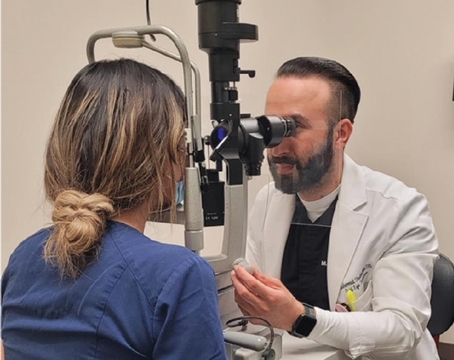Premium Cataract Surgery
If you already offer premium IOLs, either toric or presbyopia-correcting, one way to increase revenue is to increase your premium IOL conversion rate or offer higher technology options. Here are the issues to consider.
• The surgeon must buy into it. Cory Pickett, a consultant based at Turner Eye Clinic in Midland, Texas, works with several ophthalmic practices on devising ways to increase their premium surgery revenue. He says that some of the barriers to premium IOL conversion are on the physician’s side. “It’s pretty simple,” he says. “The doctor has to believe that premium IOLs are good for his patients and his practice. If either of those beliefs isn’t present, then he will be haphazardly offering these IOLs without any emotion behind it. I’ve seen doctors who come across as, ‘You can have these IOLs if you want,’ but there’s no focus and, consequently, no increase in conversions. But if the practice makes it a focus and says, ‘What steps do we need to take to at least have the opportunity to upgrade?’ then that’s a big deal.”
|
• Identify and educate the candidates. Experts say that, in order to best use your resources and not waste time, you have to make sure the patients you approach with premium lens options can actually use them. “What I teach when visiting practices is, instead of making a recommendation on a lens and then figuring out if the patient is a candidate and can pay for it, do the opposite,” says Mr. Pickett. “Figure out what the patient might be a candidate for first, and then make a strong recommendation based on that. A classic example is the patient with 2 D of astigmatism who comes in. You make a strong recommendation of a toric IOL for him, but then, a couple of minutes later, you find out that his astigmatism is in his natural lens rather than the cornea, and you have to tell him he isn’t a toric candidate after all. Now, you’ve got to backtrack and have created more confusion for him. When this happens, it’s less likely that the patient is going to upgrade to anything at all, and he may just want to get out of there.”
Austin, Texas, surgeon Steven Dell agrees. “I think the first step is to identify the correct patients who can have these technologies,” he says, “and exclude those who may have disqualifying medical conditions such as severe irregular astigmatism or perhaps loss of contrast sensitivity from glaucoma, diabetic retinopathy or macular degeneration.”
If patients are physiologically sound, Dr. Dell has found success using a brief questionnaire to weed out patients who simply aren’t interested from those who would like to hear more about their options. “Patients don’t always know these technologies exist,” Dr. Dell notes. “So they have to be educated about the fact that these are options. One of the ways that we quickly determine whether patients are interested in these technologies or not is to give them a questionnaire that simply asks the distance at which they’d like to see without spectacles after the surgery, if that were an option. One group will say, ‘Yes, I’d like to see well at distance and near without glasses,’ and another will indicate that they don’t really care about that. If a patient doesn’t have a goal of getting rid of spectacles, typically we’ll check in with him one final time later and ask, ‘We wanted to make sure it doesn’t really matter to you that you wear spectacles,’ and, if he doesn’t care, we’ll stop the process of educating him about astigmatic and/or presbyopic correction.”
Mr. Pickett says it can pay to have a separate area for educating potential premium IOL patients so they can feel relaxed when reviewing the information. “We created an area we call the Sight Selector that makes use of an iPod, iPad or other media player,” he says. “On the device, we can select the conditions the patient might have—such as hyperopia or astigmatism—and it will go through the various lens options and show a consent video. We try to individualize the educational process. Following that, a counselor will meet with the patient and discuss the benefits of specific technologies, but not so much pricing. Then, the doctor will come in and make a strong recommendation, already aware of what the patient’s been educated about.”
Dr. Dell also thinks electronic media are a big help. “We use educational tools such as products from Eyemaginations, their Echo software in particular,” he says. “This allows us to quickly illustrate to the patient what we mean when we talk about presbyopia, and what we really mean when we say ‘intermediate vision,’ because people may have different ideas about what the intermediate vision distance is.”
Mr. Pickett says one of the most popular and successful ideas his practice has instituted has been the use of mailers for cataract patients. “When a patient calls for an appointment and has already been diagnosed with a cataract, we send a custom mailer to him showing what the potential options are regarding different lens types and what the fee schedule is,” he says. “So, these people actually get an introduction to this information before they even get to the practice. Sometimes, having the fee schedule in it works in our favor because we don’t have to discuss the fees too much, and some patients will come in and say, “Yes, I want this particular lens.” The mailer also contains a menu that describes the benefit you might get with each lens, with four criteria being distance, near, astigmatism and night vision. This is very easy for the patient to understand. Rather than trying to make him understand the difference between an accommodative lens and a diffractive IOL, this tells him what the potential benefit is to him.”
• Offer multiple options. A big mistake some practices make, the experts say, is only offering two options: a basic surgery and a premium one. If you offer more, the thinking goes, you’ll find more patients upgrading in one shape or form. “When it comes to conversion rate, of course everyone wants to convert close to 100 percent,” says Mr. Pickett. “Having more options increases this upgradeability. A big patient objection is cost; that’s why adding other services is a big deal. We started offering very basic upgrade packages with a simple limbal relaxing incision or the use of extra diagnostic tools to determine which aspheric IOL might be best for a patient who wants one. You build these costs into a package in a way that lets a patient go for a lower-cost upgrade but still feel that he’s getting a higher technology. I’ve seen such initial-tier upgrades priced for as little as $200 to $300 per eye or close to $1,000 per eye if a femtosecond cataract laser is used. The patients sign an advanced beneficiary notice that acknowledges that the additional service isn’t covered by insurance and that they will pay for it.”
Dr. Dell also thinks multiple tiers are the way to go. “The way we approach it with our patients is to have three tiers: basic surgery covered by Medicare or insurance; a ‘distance package’ that typically involves an LRI, done by a laser or by hand, or a toric lens; and then a package we refer to by the copyrighted term ‘Full Focus Cataract Surgery,’ which corrects both distance and near vision.” Like Mr. Pickett with his mailer, Dr. Dell says it’s always best to speak in terms of benefits, not nuts and bolts of technologies. “We don’t say, ‘If you get this lens or this type of astigmatic correction, there will be one price, and if you get a different technology there will be another,’ ” he says. “We talk in terms of potential results. In truth, from a marketing standpoint, having three tiers will certainly mean that many patients won’t pick the top tier, but the number who pick the bottom tier will also go down. Most patients, I think, will pick the middle or the top tier.”
In addition to tiers, Mr. Pickett adds that some practices will offer initial diagnostic testing with advanced instruments—not usually reimbursed by Medicare—to help determine if someone is a candidate for premium lenses and which one might be best. “I’ve seen a $99-dollar package where the only thing the patient is paying for is the diagnostics outside the normal exams,” he says. “I’ve seen the package consist of corneal topography and/or such technology as the OPD Scan from Nidek/Marco. The topography can detect irregularities and determine if the astigmatism is asymmetrical. Just make sure that you’re upfront with what’s on the ABN before doing such an upgrade, and describe what is, and isn’t, considered included for normal cataract surgery.”
• Keep expectations in check. Though you want patients to be enthusiastic about premium lenses, you don’t want them to be too excited and set themselves up for postop dissatisfaction. “I think the way to head off some of these problems is to have a frank discussion with the patient, saying, ‘Here’s what I think I can realistically deliver,’ ” Dr. Dell says. “We’re very, very careful about underpromising what we can actually achieve with these implants, both in spoken and written communication. Regardless of the technology, I tell them that our goal is to reduce their need for glasses, but that it’s unusual for us to completely eliminate it. And, when patients enter into the process thinking that this is our goal, the overwhelming majority of them are spectacle-free and are elated. And the ones who aren’t spectacle-free get the result that they were told is the most likely outcome for them.”
Cosmetic Offerings
Some practices may choose to range farther afield from just increasing their premium cataract offerings and may decide that there’s additional revenue to be gained by offering their patients cosmetic treatments. Here, surgeons provide advice on the two most common treatments a “beginner” should start with: Botox and filler injections.
• Spread the word. If you’re going to begin offering Botox and/or fillers to your patients, surgeons say you’ve got to let them know about it. Fortunately, they say, this doesn’t have to be expensive. “It’s mostly word-of-mouth,” says Chicago ophthalmologist Adam Cohen, who performs a range of cosmetic procedures at his practice. “You have to be proactive and promote yourself. Pass your card out when you can, and set up relationships with health spas and salons. If you intend to spend some money on advertising, concentrate on the Internet and your website.”
Cincinnati, Ohio, surgeon Jeffrey Nerad, a past president of the American Society of Ophthalmic Plastic and Reconstructive Surgery, says that ophthalmologists can often draw on their existing patients. “The advantage is we have patients coming into our office,” he says. “The disadvantage is they don’t necessarily expect you to offer Botox or fillers, so you have to promote those services in your waiting room and through your staff. It’s a very competitive market, and you will have to compete against physicians who are spending thousands of dollars to set up posters along the interstate. This will be tough unless you can draw on your own patient population.”
• Accommodate the patients. As more patients begin to come to your office for cosmetic procedures, surgeons say you will have to treat them differently than your average patient. “I’m half cosmetic and half functional patients now,” explains Dr. Cohen. “It’s tricky. You can’t have a conventional medical office and think someone will come in for Botox or cosmetic surgery. You can’t have an old phoropter and slit lamp in the room with some eye charts on the wall. Consider having a small room or area for meeting with these clients. Think about your waiting room also: It’s really something that’s very important, because you want the patients to have a positive impression right away. Rather than have a separate waiting room for your cosmetic and ‘regular’ patients, though, maybe just consider spacing them out so they don’t overlap.”
Dr. Nerad says only to go high-end if you find success with current patients. “We have separate entrances and exits for pre- and postop patients, and a spa area for self-pay vs. the waiting area for insurance patients,” he says. “All that’s good, but if you’re just starting, it would be a considerable expense that you’d have to weigh against the money you’re going to recoup.”
|
• Botox. Surgeons say that, since Botox has been commoditized, a lot of the success with it revolves around pricing. “Every kind of health-care provider does Botox and fillers now,” says Dr. Nerad. “This includes nurses and dentists. I even had a patient who was getting Botox from his cardiac surgeon. Patients shop for the cheapest price.”
Dr. Cohen breaks the pricing down: “You may be doing it for $12 per unit, and there are 100 units in bottle, so you’ll make $1,200,” he says. “A bottle of Botox costs $525, bringing you down to making $675. Subtract $25 or $30 for supplies and you’re making around $625. So, you have to sell a lot of Botox to really make a go of it, since you can make around $600 for a cataract that takes 10 minutes. The other consideration is, Botox patients come back to you and say that it’s not working and they want more, so you wind up giving a little more of it for free because it makes good business sense.”
• Fillers. Dr. Nerad says that, unlike Botox, there are various types of fillers to choose from, and it’s in the physician’s best interest to start with the most benign. “There are a number of reversible fillers that have a high safety index—the hyaluronic acid-based fillers,” he explains. “Hyaluronic acid is a natural material that’s found in the human body, and the safer fillers are the HA fillers like Restylane, Juvederm and Expressions. The problem is that HA fillers are relatively short-acting, lasting roughly six months. To increase the duration of action, manufacturers will put additional materials in, such as the filler Radiesse, which uses calcium particles to extend its life; or Artefill, which uses plastic microspheres. However, any time you add an unnatural product to a filler, it has the potential to create problems in which your body reacts to the filler, causing inflammation.
“At the far end of the spectrum of duration is injecting the patient’s own fat,” Dr. Nerad continues. “But this is a procedure most ophthalmologists shouldn’t enter lightly, since it involves liposuction and is more involved. That’s why I advise the general ophthalmologist to start with safe fillers like the HA-based ones. Once they establish the clientele, or they feel they know what they’re doing, they can add something more complicated.”
In terms of pricing, Dr. Cohen says he charges $650 per tube of filler. “Some people charge $600, and some charge $550, depending on how they want to work it,” he says. “A tube costs $240, leaving around $410 of profit. Effective pricing is also dependent on your location and who you are in the cosmetic realm. If you’re well-known, you’ll get more of a premium than someone who’s up-and-coming.”
• Aestheticians. If you have the space and the patients, one move some physicians make is to add an aesthetician’s cosmetic services. “I have quite a few aestheticians,” says Dr. Cohen. “We have rotating aestheticians who move through various practice locations. Some work on salary, and some on commission. They can be successful, but they require a separate room that’s tailored to fulfill the needs of patients. The room needs a nice table, a waxing machine, a variety of skin peels, cosmeceuticals, sundry inventory, towels and a towel warmer. It’s a spa room; it can’t be anything else. The room can cost between $1,500 and $5,000 to create, depending on how much you want to offer.”
Dr. Nerad says that, in his experience, the main benefit of the aesthetician has been as a feeder for his surgical services. “I have a medi-spa sort of setting with three aestheticians,” he says. “Basically, it’s kind of a breakeven deal. Selling products and the aesthetician’s services pay for themselves, but the way it makes revenue is through what it generates for me in terms of referrals for surgery like blepharoplasties. There’s potential there, but it’s competitive.”
Dr. Nerad says that, though offering cosmetic services may seem like a daunting new direction, ironically, the chemicals used the most are actually closely tied to ophthalmology. “I mention to patients that hyaluronic acid and Botox were both developed by ophthalmologists,” he says. “The first Botox injection was used by Alan Scott for cross-eyed children in the 80s and then for treating blepharospasm, and Healon is a type of hyaluronic acid that’s been used in cataract surgery for a long time. So, there’s a long history of the use of these products by eye surgeons. However, for ophthalmologists, I caution that this is no guarantee of success.” REVIEW






